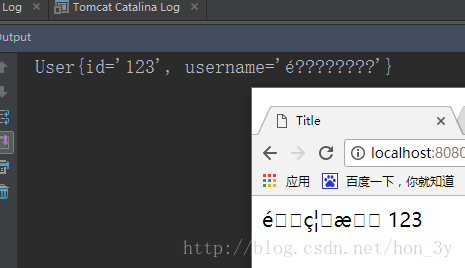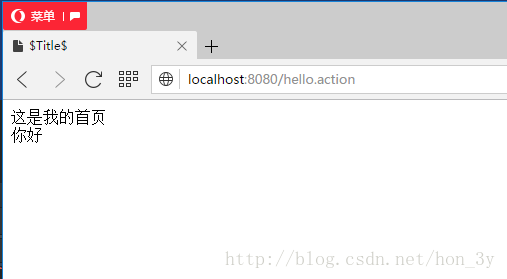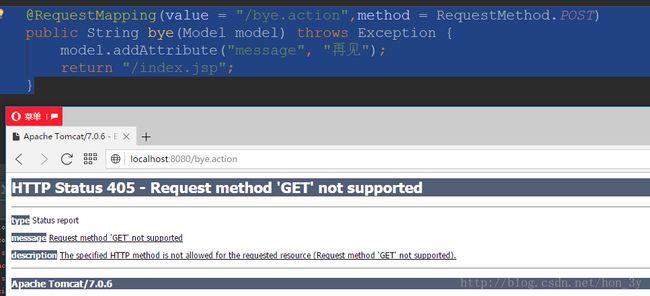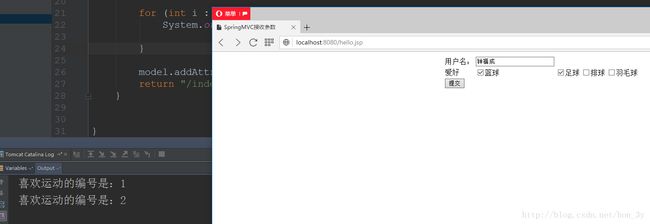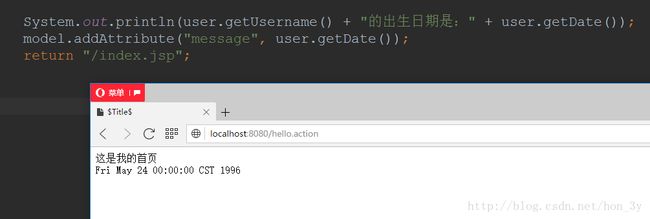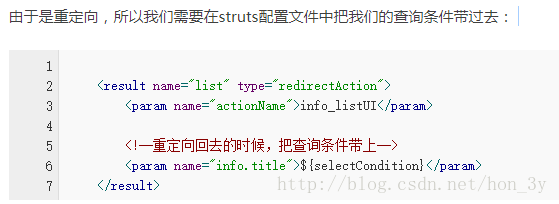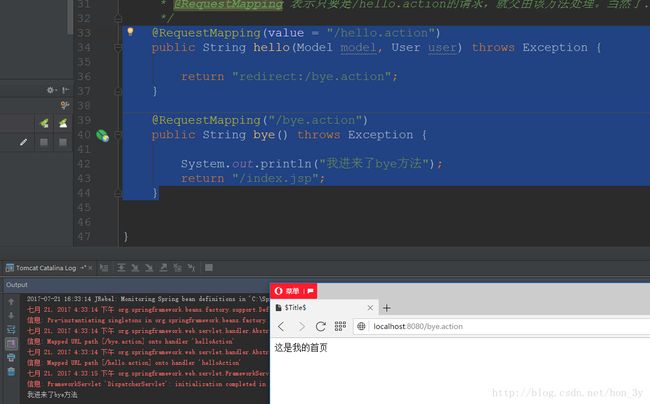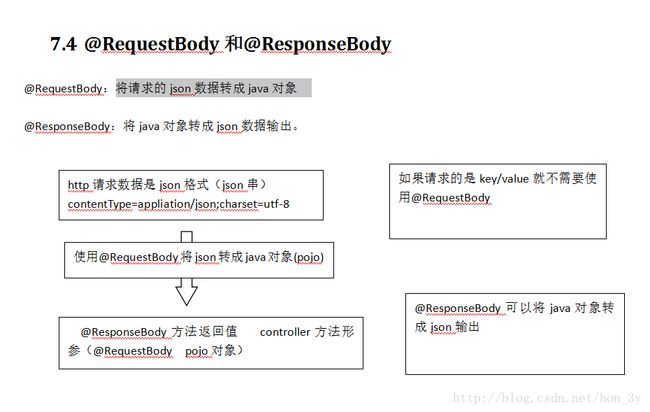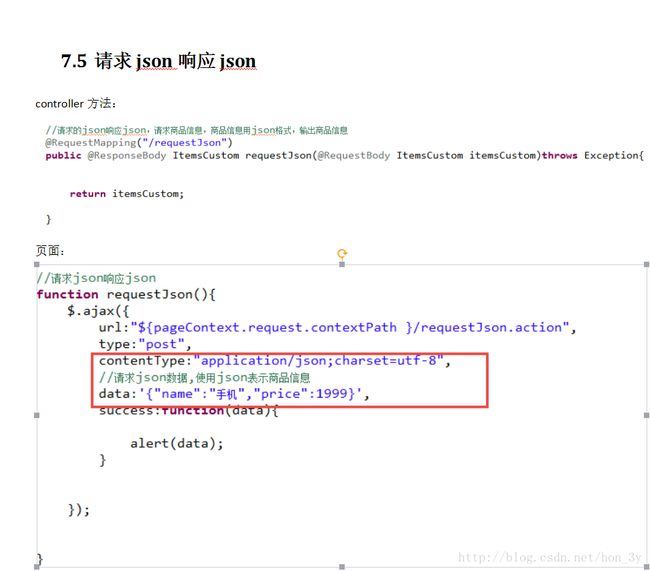前言
本文主要是讲解在Controller中的开发,主要的知识点有如下:
- 编码过滤器
- 使用注解开发
- 注解
@RequestMapping详解 - 业务方法接收参数
- 字符串转日期
- 重定向和转发
- 返回JSON
SpringMVC过滤编码器
在SpringMVC的控制器中,如果没有对编码进行任何的操作,那么获取到的中文数据是乱码!
即使我们在handle()方法中,使用request对象设置编码也不行!原因也非常简单,我们SpringMVC接收参数是通过控制器中的无参构造方法,再经过handle()方法的object对象来得到具体的参数类型的。
Struts2是使用拦截器来自动帮我们完成中文乱码的问题的。那么SpringMVC作为一个更加强大的框架,肯定也有对应的方法来帮我们完成中文乱码问题!
值得注意的是:该过滤编码器只能解决POST的乱码问题!
我们只需要在web.xml配置文件中设置过滤编码器就行了!
CharacterEncodingFilter
org.springframework.web.filter.CharacterEncodingFilter
encoding
UTF-8
CharacterEncodingFilter
/*
注解开发SpringMVC
我们在快速入门的例子中使用的是XML配置的方式来使用SpringMVC的,SpringMVC也能够支持注解。【个人非常喜欢注解的方式】
我们在使用Action的时候,要么继承着AbstractCommandController类,要么显示使用注解Controller接口。当我们使用了注解以后就不用显示地继承或实现任何类了!
开发流程
使用@Controller这个注解,就表明这是一个SpringMVC的控制器!
@Controller
public class HelloAction {
}
当然了,现在Spring是不知道有这么一个注解的,因此我们需要在配置文件中配置扫描注解
值得注意的是:在配置扫描路径的时候,后面不要加.*
不然扫描不了,我不知道学Struts2还是其他的地方时候,习惯加了.*,于是就搞了很久!
在控制器中写业务方法
@Controller
public class HelloAction {
/**
*
* @RequestMapping 表示只要是/hello.action的请求,就交由该方法处理。当然了.action可以去掉
* @param model 它和ModelAndView类似,它这个Model就是把数据封装到request对象中,我们就可以获取出来
* @return 返回跳转的页面【真实路径,就不用配置视图解析器了】
* @throws Exception
*/
@RequestMapping(value="/hello.action")
public String hello(Model model) throws Exception{
System.out.println("HelloAction::hello()");
model.addAttribute("message","你好");
return "/index.jsp";
}
}
跳转到index页面,首页得到对应的值。
<%@ page contentType="text/html;charset=UTF-8" language="java" %>
$Title$
这是我的首页
${message}
当然了,基于注解和基于XML来开发SpringMVC,都是通过映射器、适配器和视图解析器的。 只是映射器、适配器略有不同。但是都是可以省略的!
更新:上边的适配器和映射器只是Spring3.1版本之前使用的、3.1版本之后现在一般用以下的两个
映射器:
org.springframework.web.servlet.mvc.method.annotation.RequestMappingHandlerMapping
适配器:
org.springframework.web.servlet.mvc.method.annotation.RequestMappingHandlerAdapter
当然了,这上面两个配置也可以使用
RequestMapping
**@RequestMapping能够控制请求路径和请求方式!**
一个控制器写多个业务方法
到目前为止,我们都是一个控制器写一个业务方法,这肯定是不合理的。我们在Struts2中一个Action就对应多个业务方法了。那么我们在SpringMVC中又怎么写呢???
其实我们可以推理出来,@RequestMapping就是用于配置哪个请求对应哪个业务方法的!
public @interface RequestMapping {
String[] value() default {};
RequestMethod[] method() default {};
String[] params() default {};
String[] headers() default {};
}
当我们请求hello.action的时候,处理的业务方法是hello().....当我们请求bye.action的时候,处理的业务方法是bye()
@Controller
public class HelloAction {
/**
*
* @RequestMapping 表示只要是/hello.action的请求,就交由该方法处理。当然了.action可以去掉
* @param model 它和ModelAndView类似,它这个Model就是把数据封装到request对象中,我们就可以获取出来
* @return 返回跳转的页面【真实路径,就不用配置视图解析器了】
* @throws Exception
*/
@RequestMapping(value="/hello.action")
public String hello(Model model) throws Exception{
System.out.println("HelloAction::hello()");
model.addAttribute("message","你好");
return "/index.jsp";
}
@RequestMapping(value = "/bye.action")
public String bye(Model model) throws Exception {
model.addAttribute("message","再见");
return "/index.jsp";
}
}
分模块开发
当然了,我们在Struts2常常使用namespace来进行分模块开发,在SpringMVC中我们也可以这样干,并且我们又是使用的是@RequestMapping这个注解!
只要把@RequestMapping这个注解写到类上面去,就代表了分模块。
@Controller
//我们知道,如果是value属性上的注解,我们可以把value省略掉的
@RequestMapping("/zhongfucheng")
public class HelloAction {
/**
* @param model 它和ModelAndView类似,它这个Model就是把数据封装到request对象中,我们就可以获取出来
* @return 返回跳转的页面【真实路径,就不用配置视图解析器了】
* @throws Exception
* @RequestMapping 表示只要是/hello.action的请求,就交由该方法处理。当然了.action可以去掉
*/
@RequestMapping(value = "/hello.action")
public String hello(Model model) throws Exception {
System.out.println("HelloAction::hello()");
model.addAttribute("message", "你好");
return "/index.jsp";
}
@RequestMapping(value = "/bye.action")
public String bye(Model model) throws Exception {
model.addAttribute("message", "再见");
return "/index.jsp";
}
}
那么我们想要HelloAction该控制器处理我们的请求,访问的地址要么是:http://localhost:8080/zhongfucheng/hello.action,或者要么是http://localhost:8080/zhongfucheng/bye.action
限定某个业务控制方法,只允许GET或POST请求方式访问
我们如果想要限定某个业务控制方法,只允许GET或POST请求方式访问。还是通过@RequestMapping来实现。只要设定它的method属性就行了!
@RequestMapping(value = "/bye.action",method = RequestMethod.POST)
public String bye(Model model) throws Exception {
model.addAttribute("message", "再见");
return "/index.jsp";
}
当我把业务方法的请求设置为POST以后,我想要通过GET方式来访问该业务方法。就行不通了!
业务方法写入传统web参数
我们的业务方法除了可以写Model这个参数以外,如果有需要我们还可以写request,response等传统Servlet的参数。这是一样可以使用的....
但是呢,我们并不建议使用传统的web参数,因为会耦合
@RequestMapping(method=RequestMethod.POST,value="/register")
public String registerMethod(HttpServletRequest request,HttpServletResponse response) throws Exception{
//获取用户名和薪水
String username = request.getParameter("username");
String salary = request.getParameter("salary");
System.out.println("用户注册-->" + username + ":" + salary);
//绑定到session域对象中
request.getSession().setAttribute("username",username);
request.getSession().setAttribute("salary",salary);
//重定向/jsp/success.jsp页面
//response.sendRedirect(request.getContextPath()+"/jsp/success.jsp");
//转发/jsp/ok.jsp页面
request.getRequestDispatcher("/jsp/ok.jsp").forward(request,response);
//转发(提倡)
return "/jsp/success.jsp";
}
小细节:如果我们的返回值是返回一个真实路径,而我们在程序中又使用了转发或重定向。。。那么具体跳转的位置就是按我们程序中跳转的路径为准!
业务方法收集参数
我们在Struts2中收集web端带过来的参数是在控制器中定义成员变量,该成员变量的名字与web端带过来的名称是要一致的...并且,给出该成员变量的set方法,那么Struts2的拦截器就会帮我们自动把web端带过来的参数赋值给我们的成员变量....
那么在SpringMVC中是怎么收集参数的呢????我们SpringMVC是不可能跟Struts2一样定义成员变量的,因为SpringMVC是单例的,而Struts2是多例的。因此SpringMVC是这样干的:
- 业务方法写上参数
- 参数的名称要和web端带过来的数据名称要一致
接收普通参数
如果是普通参数的话,我们直接在方法上写上与web端带过来名称相同的参数就行了!
@RequestMapping(value = "/hello.action")
public String hello(Model model, String username, int id) throws Exception {
System.out.println("用户名是:" + username);
System.out.println("编号是:" + id);
model.addAttribute("message", "你好");
return "/index.jsp";
}
效果:
接收JavaBean
我们处理表单的参数,如果表单带过来的数据较多,我们都是用JavaBean对其进行封装的。那么我们在SpringMVC也是可以这么做的。
- 创建Javabean
- javaBean属性与表单带过来的名称相同
- 在业务方法上写上Javabean的名称
创建JavaBean,javaBean属性与表单带过来的名称相同
public class User {
private String id;
private String username;
public User() {
}
public User(String id, String username) {
this.id = id;
this.username = username;
}
public String getId() {
return id;
}
public void setId(String id) {
this.id = id;
}
public String getUsername() {
return username;
}
public void setUsername(String username) {
this.username = username;
}
@Override
public String toString() {
return "User{" +
"id='" + id + '\'' +
", username='" + username + '\'' +
'}';
}
}
在业务方法参数上写入Javabean
@RequestMapping(value = "/hello.action")
public String hello(Model model,User user) throws Exception {
System.out.println(user);
model.addAttribute("message", "你好");
return "/index.jsp";
}
收集数组
收集数组和收集普通的参数是类似的,看了以下的代码就懂了。
业务方法获取参数
@RequestMapping(value = "/hello.action")
public String hello(Model model,int[] hobby) throws Exception {
for (int i : hobby) {
System.out.println("喜欢运动的编号是:" + i);
}
model.addAttribute("message", "你好");
return "/index.jsp";
}
效果:
收集List集合
我们在Spring的业务方法中是不可以用List,SpringMVC给了我们另一种方案!
我们使用一个JavaBean把集合封装起来,给出对应的set和get方法。那么我们在接收参数的时候,接收的是JavaBean
/**
* 封装多个Emp的对象
* @author AdminTC
*/
public class Bean {
private List empList = new ArrayList();
public Bean(){}
public List getEmpList() {
return empList;
}
public void setEmpList(List empList) {
this.empList = empList;
}
}
业务方法接收JavaBean对象
/**
* 批量添加员工
*/
@RequestMapping(value="/addAll",method=RequestMethod.POST)
public String addAll(Model model,Bean bean) throws Exception{
for(Emp emp:bean.getEmpList()){
System.out.println(emp.getUsername()+":"+emp.getSalary());
}
model.addAttribute("message","批量增加员工成功");
return "/jsp/ok.jsp";
}
在JSP页面直接写上empList[下表].
其实这种方法看起来也没有那么难理解,我们就是向上封装了一层【与接收普通的JavaBean类似的】。
收集多个模型
我们有可能在JSP页面上即有User模型的数据要收集,又有Emp模型的数据要收集....并且User模型的属性和Emp模型的属性一模一样....此时我们该怎么办呢???
我们也是可以在User模型和Emp模型上向上抽象出一个Bean,该Bean有Emp和User对象
/**
* 封装User和Admin的对象
* @author AdminTC
*/
public class Bean {
private User user;
private Admin admin;
public Bean(){}
public User getUser() {
return user;
}
public void setUser(User user) {
this.user = user;
}
public Admin getAdmin() {
return admin;
}
public void setAdmin(Admin admin) {
this.admin = admin;
}
}
在JSP页面收集的时候,给出对应的类型就行了。
字符串转日期类型
我们在Struts2中,如果web端传过来的字符串类型是yyyy-mm-dd hh:MM:ss这种类型的话,那么Struts2默认是可以自动解析成日期的,如果是别的字符串类型的话,Struts2是不能自动解析的。要么使用自定义转换器来解析,要么就自己使用Java程序来解析....
而在SpringMVC中,即使是yyyy-mm-dd hh:MM:ss这种类型SpringMVC也是不能自动帮我们解析的。我们看如下的例子:
JSP传递关于日期格式的字符串给控制器...
User对象定义Date成员变量接收
public Date getDate() {
return date;
}
public void setDate(Date date) {
this.date = date;
}
业务方法获取Date值
@RequestMapping(value = "/hello.action")
public String hello(Model model, User user) throws Exception {
System.out.println(user.getUsername() + "的出生日期是:" + user.getDate());
model.addAttribute("message", "你好");
return "/index.jsp";
}
结果出问题了,SpringMVC不支持这种类型的参数:
现在问题就抛出来了,那我们要怎么解决呢????
SpringMVC给出类似于Struts2类型转换器这么一个方法给我们使用:如果我们使用的是继承AbstractCommandController类来进行开发的话,我们就可以重写initBinder()方法了....
具体的实现是这样子的:
@Override
protected void initBinder(HttpServletRequest request,ServletRequestDataBinder binder) throws Exception {
binder.registerCustomEditor(Date.class,new CustomDateEditor(new SimpleDateFormat("yyyy-MM-dd"),true));
}
那我们现在用的是注解的方式来进行开发,是没有重写方法的。因此我们需要用到的是一个注解,表明我要重写该方法!
@InitBinder
protected void initBinder(HttpServletRequest request, ServletRequestDataBinder binder) throws Exception {
binder.registerCustomEditor(
Date.class,
new CustomDateEditor(new SimpleDateFormat("yyyy-MM-dd"), true));
}
再次访问:
值得注意的是:如果我们使用的是Oracle插入时间的话,那么我们在SQL语句就要写TimeStrap时间戳插入进去,否则就行不通!
结果重定向和转发
我们一般做开发的时候,经常编辑完数据就返回到显示列表中。我们在Struts2是使用配置文件进行重定向或转发的:
而我们的SpringMVC就非常简单了,只要在跳转前写上关键字就行了!
public String hello(Model model, User user) throws Exception {
System.out.println(user.getUsername() + "的出生日期是:" + user.getDate());
model.addAttribute("message", user.getDate());
return "redirect:/index.jsp";
}
以此类推,如果是想要再次请求的话,那么我们只要写上对应的请求路径就行了!
@RequestMapping(value = "/hello.action")
public String hello(Model model, User user) throws Exception {
return "redirect:/bye.action";
}
@RequestMapping("/bye.action")
public String bye() throws Exception {
System.out.println("我进来了bye方法");
return "/index.jsp";
}
返回JSON文本
回顾一下Struts2返回JSON文本是怎么操作的:
- 导入jar包
- 要返回JSON文本的对象给出get方法
- 在配置文件中继承json-default包
- result标签的返回值类型是json
那么我们在SpringMVC又怎么操作呢???
导入两个JSON开发包
- jackson-core-asl-1.9.11.jar
- jackson-mapper-asl-1.9.11.jar
在要返回JSON的业务方法上给上注解:
@RequestMapping(value = "/hello.action")
public
@ResponseBody
User hello() throws Exception {
User user = new User("1", "zhongfucheng");
return user;
}
配置JSON适配器
测试的JSP
测试:
Map测试:
@RequestMapping(value = "/hello.action")
public
@ResponseBody
Map hello() throws Exception {
Map map = new HashMap();
User user = new User("1", "zhongfucheng");
User user2 = new User("12", "zhongfucheng2");
map.put("total", user);
map.put("rows", user2);
return map;
}
更新------------------------------------------------------------------
如果传递进来的数据就是JSON格式的话,我们我们需要使用到另外一个注解@RequestBody,将请求的json数据转成java对象
总结
- 使用注解的开发避免了继承多余的类,并且非常简洁高效。
- 想要中文不乱码,仅仅设置request的编码格式是不行的。因为SpringMVC是通过无参的构造器将数据进行封装的。我们可以使用SpringMVC提供的过滤器来解决中文乱码问题。
- RequestMapping可以设置我们具体的访问路径,还可以分模块开发。基于这么两个原因,我们就可以在一个Action中写多个业务方法了。
- RequestMapping还能够限制该请求方法是GET还是POST。
- 在我们的业务方法中,还可以使用传统的request和response等对象,只不过如果不是非要使用的话,最好就别使用了。
- 对于SpringMVC自己帮我们封装参数,也是需要使用与request带过来的名称是相同的。如果不相同的话,我们需要使用注解来帮我们解决的。
- 如果是需要封装成集合,或者封装多个Bean的话,那么我们后台的JavaBean就需要再向上一层封装,在业务方法上写上Bean进行了。当然了,在web页面上要指定对应Bean属性的属性。
- 字符串转日期对象用到
@InitBinder注解来重写方法。 - 返回JSON对象,我们就需要用到
@ResponseBody注解,如果接收JSON数据封装成JavaBean的话,我们就需要用到@RequestBody注解。随后在配置文件上创建对应的bean即可。
如果文章有错的地方欢迎指正,大家互相交流。习惯在微信看技术文章,想要获取更多的Java资源的同学,可以关注微信公众号:Java3y
